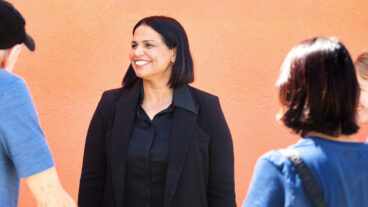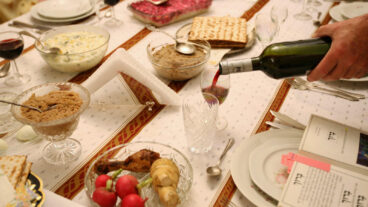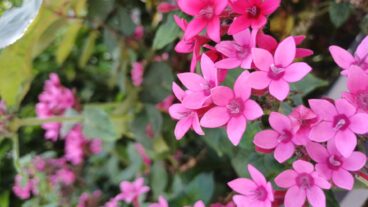Jewish and Arab children and guides play and learn together at the Bible Lands Museum in Jerusalem as part of the program The Image of Abraham.Children sit in a circle on the floor, Arabs and Jews paired off together, playing a game of bingo that is teaching them about their different religious practices and beliefs.
“Does anybody want to tell us what prayer is?” asks the Jewish guide.
“We ask for things to be good,” answers Doron, 10.
“Both Jews and Arabs pray,” says the guide. “Jews pray three times a day, does anyone know the names of these prayers?”
The Arab guide translates and then explains to the Arab children that Moslems pray five times a day. They both pass around prayer books for the children to look at.
“Ibrahim, Abraham,” says the Arab guide.
One of the Arab children asks: “Which one?”
“It’s both the same,” she answers.
When the children are told their bingo game is over, they all protest. They have been loving it.
This unusual scene takes place at the Bible Lands Museum in Jerusalem, the result of an innovative Israeli initiative. The museum runs an educational program – the Image of Abraham – which encourages Arab and Jewish children from Jerusalem to come together to examine their joint heritage.
Using the journey of Abraham as a springboard, fourth graders from both sides of the divide get together in the plush peaceful setting of the museum, among artifacts that are thousands of years old and silent witnesses to their common heritage.
They play learning games together, as well as do arts and crafts, play ball, tag and other international children’s games. They teach each other how to write their names in Hebrew and Arabic. They also learn how to write their names in hieroglyphics, and create a shared Arabic/Hebrew dictionary.
Now in its seventh year, the project unites children from two Jerusalem schools – the Paula Ben-Gurion School in Rehavia, and the Ramat Moriah School in East Talpiot – with children from the Al-Ukhwah School in Jabel Mukaber, an Arab village in east Jerusalem.
“By using ancient history as a launching point, we are able to deal in a non-confrontational way with serious issues that face us,” the museum’s deputy director Amanda Weiss told ISRAEL21c.
“When the project began in 1997,” added program manager Suha Ibrahim, “there was a period of peace and the future of the Middle East looked bright. It was decided that it was the right moment to give Arab and Jewish children the opportunity to learn about each other, and many meetings were arranged between the youth in Abu Ghosh, Ein Rafa and Mevasseret Zion (The first two are Arab towns and the third a Jewish neighborhood on the outskirts of Jerusalem.). The idea was to get them to understand their shared geographic area through studying the personality and history of Abraham, whom the Arabs consider their first prophet and the Jews view as their founding father.”
When the political situation took a turn for the worse in 2000, Yehuda Kaplan, head of the Educational Department of the museum refocused the program to work exclusively with children from East and West Jerusalem.
“This program has been the first opportunity for most of these children to meet their counterparts. Until now the character of the Jew has been represented for Arab children by the soldier and for many Jewish children the Arab is synonymous with the suicide bomber,” said Kaplan.
After preparatory meetings at their individual schools, the children come to the museum to learn about the history of Mesopotamia, about Canaan and Egypt, all through the perspective of Abraham and his family. Throughout the school year, classes come for four three-hour sessions on four Thursdays, two weeks apart.
“There are just four meetings per group, but the children are interested and do take away something,” says Ibrahim. “We see them open up in their play together, outside of the work or play they do in organized supervised groups. We see them ask each other questions privately, and this is a big thing, because they have never met before.”
Questions asked include ‘What’s you favorite TV show?’ ‘What’s it like to go through a checkpoint?’ and ‘Do you know anyone who was killed in a suicide bombing?’
“The idea,” says Kaplan, “is that through the kids we try to encourage communication between neighborhoods and communities.”
One of the challenges of the program, says Kaplan, is helping the kids to deal with the day-to-day situation that they live in and how hard it is to get through the day sometimes.
“The hardest barrier is language,” he says. “The children are asked to listen quietly while each group has the activities and different points explained to them in their own language.
“One of the things we try to teach them is to listen even if they don’t understand,” says Kaplan.
At the end of the year a ceremony will take place to which parents will be invited. Last year this was held on the museum premises, but this year, says Kaplan, they hope to hold it at an open-air venue and include activities which will combine parents and children.
“We are also inviting parents to participate during the kids’ meetings. Last year we held a parallel program on each fourth encounter of children. When the parents met during the kids’ meetings the atmosphere was pleasant and they requested a more organized framework.”
In light of the keenness of the adults, this year the museum has started a group for parents exclusively, to meet each other once a month; the second of these meetings will take place at the end of February.
In an arts and crafts group, the children prepare models of the different places Abraham passed through on his journey. As they construct models of Abraham and his family, they discuss their own families.
Marua 10, from East Jerusalem, says she is happy to meet new people and to understand new things.
Tamar, 9 ½, says the program is lots of fun and she likes doing arts and crafts with her Arab friends because that way they can play together even if they can?t understand each other’s language.
For Ben, 10 from West Jerusalem, “It is very nice, lots of fun, and very different to meet the others.”
“They are children the same as us,” he says. “I think there will be peace in our country if there is peace between people.”
Joseph 10, another Jew, agrees that it is nice and fun to make new friends.
“It is still early,” he says, “but maybe one day we will visit each other in our homes.”
Hamand, 10, an Arab boy, says he likes coming to the museum. He has no other Jewish friends, but hopes to in the future.
“The project is like a young plant that we are nurturing,” says Weiss.
Back to the action, Doron plays a hand-slapping game with the girls in Arabic.
“It is a little hard to communicate because they only know Arabic and I only know Hebrew,” he says.
“But I think it is very good to put Jews and Arabs together so the next generation will be better,” says Doron. “There will be fewer wars because they will know each other better. But there will still be wars because not everybody knows everyone.”
The Image of Abraham project is doing its part to insure that one day ‘everybody will know everyone.’











